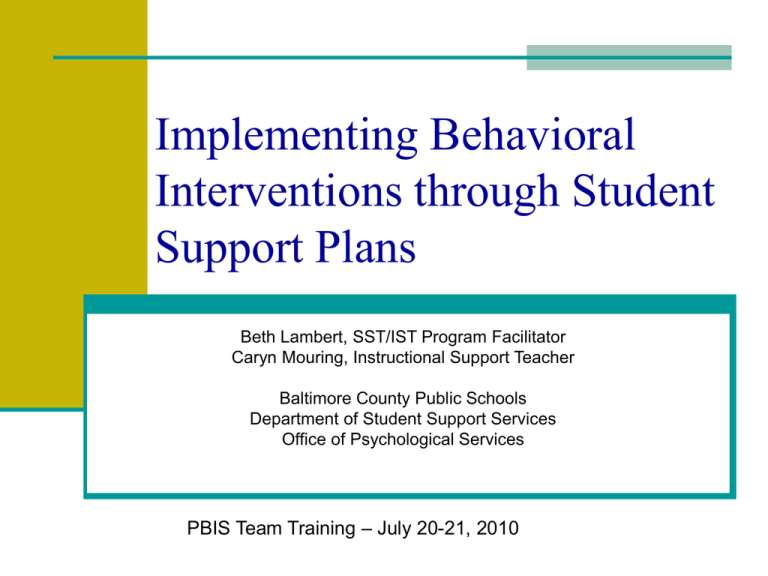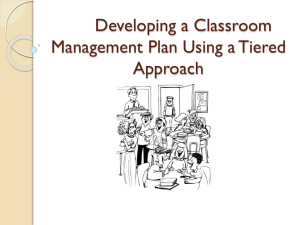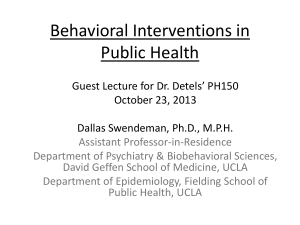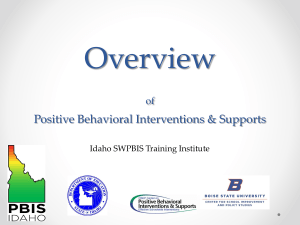Implementing Behavioral Interventions through Student Support Plans
advertisement

Implementing Behavioral Interventions through Student Support Plans Beth Lambert, SST/IST Program Facilitator Caryn Mouring, Instructional Support Teacher Baltimore County Public Schools Department of Student Support Services Office of Psychological Services PBIS Team Training – July 20-21, 2010 Session Agenda Review the “response to intervention” approach to positive behavior planning Utilize the data-based problem-solving process to develop behavioral interventions Develop a Student Support Plan that addresses complex behaviors of a student not responding to schoolwide and classroom behavior systems Identify additional effective behavioral interventions that can be easily implemented and monitored within the classroom setting Department of Student Support Services Mission Coordinates prevention and intervention programs and services: to support schools, students, and parents/guardians, by addressing the cognitive, behavioral, social, emotional, health, safety, and alternative educational needs of all students to maximize students’ potential achievement What We Know… School environments that are positive, preventive, and effective: Are safer, healthier, & more caring Have enhanced learning & teaching environment Can provide a continuum of academic and behavioral support for all students Are achievable & sustainable Systematic Academic & Behavior Planning Intervention/Team Tiers Tier 3 Intensive Interventions: FEW ~5% SOME ~15% SST/IEP Teams Small groups or individual students; alternative programs and special education instruction and/or services Tier 2 Targeted Interventions: Student Support Teams Groups of students or individual students at risk; screen and monitor; case management, student support plans, 504 plans Tier 1 Universal Interventions : PBIS Teams Grade Level Teacher Meetings ALL ~80% of Students All settings, all students; monitor and differentiate instruction; implement supplemental interventions Response to Intervention (RtI) •Specially designed instruction and services •More intensive, individualized behavior planning •Alternative instructional programs •Individualized student interventions as specified in student support plans •Supplemental instruction •Targeted interventions for groups of students or settings •Differentiated instruction based on frequent progress monitoring •Effective classroom organization and behavior planning •Consistent implementation of the core curriculum •Schoolwide behavior planning Case Study Take a few minutes to review case study on Andy Consider: How would you personally address this situation? How would your school address this situation? What do you think would be the intended or unintended results of these actions? Helpful or Harmful? The Teacher’s Response: He needs an FBA/BIP “You’re out of here!” He must have an emotional disability No recess/field trips/assemblies Unintended Results: Lengthy process and need parent permission Negatively Reinforcing the inappropriate behavior Over identification Holding a student accountable for a behavior he doesn’t have control over (lack of skills?) Helpful or Harmful? The School’s Response: Extended time in the “focus room” Suspension Referral to SST/IEP team to obtain permission for assessments Unintended Results: Loss of instructional time We continue to reinforce the inappropriate behavior without identifying and addressing the underlying cause Loss of power on the teacher’s part Lengthy process/loss of time (for everyone!) Over identification Have we changed the behavior or taught a replacement behavior? Changes in Our Approach to Problem Solving The problem solving process is not about proving what’s wrong with the student. It’s about finding out how to teach the student so he or she can learn. It’s discovering who that child is …as a LEARNER. http://www.ciclt.net/ul/gael/SettingtheSSTAGEforGreatPerfomances.ppt#430,40,Slide 40 When a Student is a Non-Responder Step 1: Review Current Practices Look at universal prevention at both the system (schoolwide) and individual (classroom) levels Are the schoolwide and classroom expectations taught and reviewed frequently? Are students positively reinforced for appropriate behaviors? Have we differentiated based on the individual needs of students within the classroom, grade level, and/or setting? Still Not Responding? Step 2: Discuss at Grade Level Discuss your concerns with grade level, administration, support staff and/or parents/guardians Analyze patterns of behavior to individualize classroom-based interventions When does it happen? What are the factors that “trigger” the behavior? How have the “typical” consequences reinforced the inappropriate behavior? Identify the warning signs: Be proactive vs. reactive Does the student have the skills? What skills do we need to teach them? Determine what you want the student to be able to do (goal?) Implement interventions and document the student’s response for at least 30-45 days (Remember things usually get worse before they get better!) Still Not Responding? Step 3: Refer to SST 80 - 90% of students respond to universal positive behavioral supports and interventions 5-15% of students “slip through” and need additional, targeted supports Students who are considered “at risk” and have not responded to universal or classroom interventions may be referred to the SST for possible development of targeted group or individual interventions. Tier 2: Student Support Team (SST) Addresses more complex academic and behavioral problems of individual students, groups of students, and schoolwide concerns Implements prevention and early intervention activities prior to intensive intervention to increase student achievement, improve schoolwide climate, reduce disruptive behavior, reduce inappropriate referrals to the IEP Team, and increase parent/guardian involvement Provides a continuum of academic and behavioral interventions and supports in connection with other schoolwide initiatives such as PBIS and grade level teacher meetings and more intensive interventions like community partnerships and special education Tier 2: Student Support Team (SST) Functions of SST Screening/processing referrals Case management Mental health issues Substance abuse issues Physical/health issues Academic & behavioral interventions through Student Support Plans 504 Plans Targeted group or setting interventions (ADHD, cafeteria) Referral to IEP/Special Education Team Identify the Problem Analyze Problem & Develop a Plan Evaluate the Plan Implement the Plan & Monitor Progress Developing a Student Support Plan Identify the Problem Aggressive/explosive behaviors when given a direction (either individually or to the group) or during transitions Analyze the Problem Behaviors occur when student is unable to gain control or is frustrated Behaviors escalate when he is given consecutive verbal prompts to comply and are worse during transitions Negative consequences have not changed the behaviors (office referrals, talks with the counselor, and restriction of privileges) Student does not appear to have coping skills Developing a Student Support Plan Develop a Plan Set a goal Andy will increase the amount of times he uses the appropriate coping strategies as measured by a decrease in aggressive/explosive behaviors from 4 times a week to one or fewer episodes. Develop Interventions to Address Goal Teach, model, and practice coping strategies (see “Take a Break” and “Give Me Five” examples) Positively reinforce (Student colors part of the “Reinforcement Tower” each time he uses coping strategies) Designate a “cool down” zone to regain safe control Provide advance notice of transitions paired with individual student schedule (student moves velcro piece to indicate the next change in routine) Provide parent with copy of coping strategies and positive reinforcement system to make a connection between home and school Developing a Student Support Plan Develop a Plan Method of Monitoring Progress Classroom teacher keeps a daily log of use of coping strategies and any aggressive/explosive episodes (parent also keeps a log) Classroom teacher keeps copy of completed “Reinforcement Tower” Informal observation by teacher and support staff member Developing a Student Support Plan Implement and Monitor the Plan Provide appropriate training for all staff members who will implement the interventions Review log daily Assign a staff member to check in with the classroom teacher to help trouble-shoot Ensure fidelity of the implementation of the plan Fidelity of Implementation: Example Forms STUDENT: TEACHER/CLASS PERIOD: Area DATE: Level of Implementation Materials and Time Teacher has her and checks on student 2 1 intervention sheet ready at beginning of class Teacher provides student time mgmt cues 2 1 throughout class period INTERVENTION 0 0 Teacher follows 4 steps of the intervention 2 1 0 Uses clear signals and cues to redirect 2 1 0 Provides students many opportunities to respond and reinforce appropriate behavior Models skills/strategies appropriately and with ease 2 1 0 2 1 0 2 1 0 2 1 0 2 1 0 2 1 0 2 1 0 2 1 0 2 1 0 Corrects all errors using correct technique Student asks for teacher assistance as outlined in intervention Student uses correct responses outlined in intervention Teacher helps provide time cues and transitional cues outlined in intervention Teacher maintains good pacing, allows for student response time Student tallies behaviors using selfmonitoring form Teacher documents progress monitoringbehavioral tallies Comments Developing a Student Support Plan Evaluate the plan Review the data to determine progress made towards goal (Remember, change is a process, not an event!) Make revisions to the goal and/or interventions as needed Consider phasing out interventions that are not needed and incorporating self-monitoring If the student did not make progress, consider whether the intervention was implemented with fidelity or whether the correct problem was identified Additional Behavioral Interventions Inattention Focus Buttons Focus Additional Behavioral Interventions Inattention Self-Monitoring – “Am I Working?” Additional Behavioral Interventions Anger, Frustration, Sensory Stimulation Touch the Dot Strategy Additional Behavioral Interventions Anger, Frustration, Sensory Stimulation “Push It Out” Sanity Savers Final Thoughts… Systematic academic and behavior planning increases instructional time and student engagement, and creates positive school climates that are conducive to learning over time Problem-solving should occur at every tier; it begins in the classroom and at grade level in order to demonstrate “response to intervention” and address student concerns early on Student Support Plans are an effective means of developing, implementing, and monitoring behavioral interventions that target specific, measurable behaviors for students who are not responding to schoolwide and classroom-based positive behavior systems Thank you! Questions: blambert2@bcps.org cmouring@bcps.org Feel free to contact us anytime!








